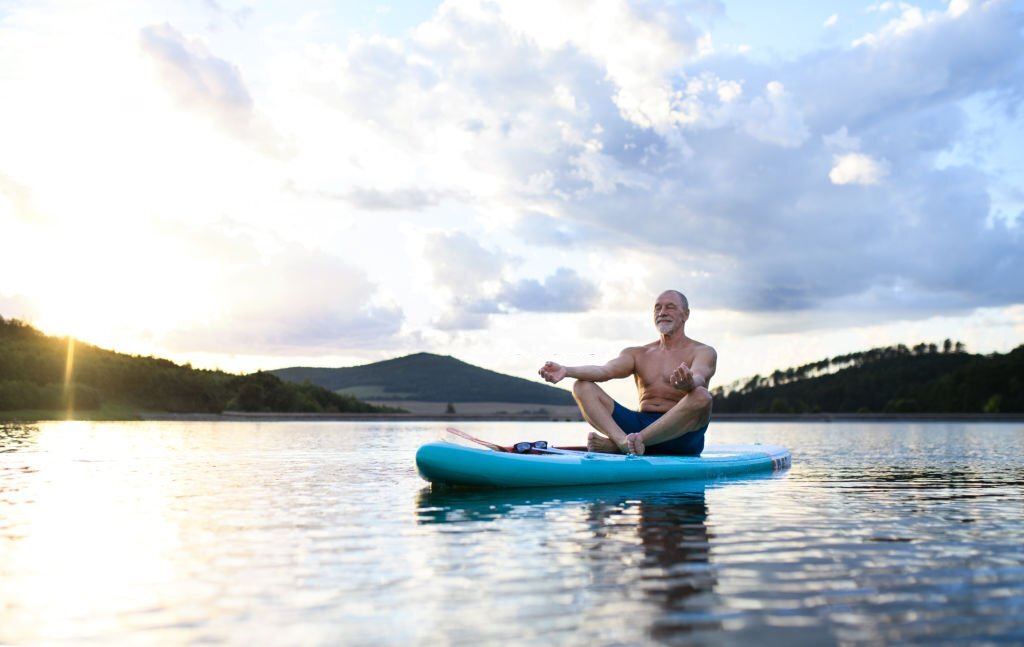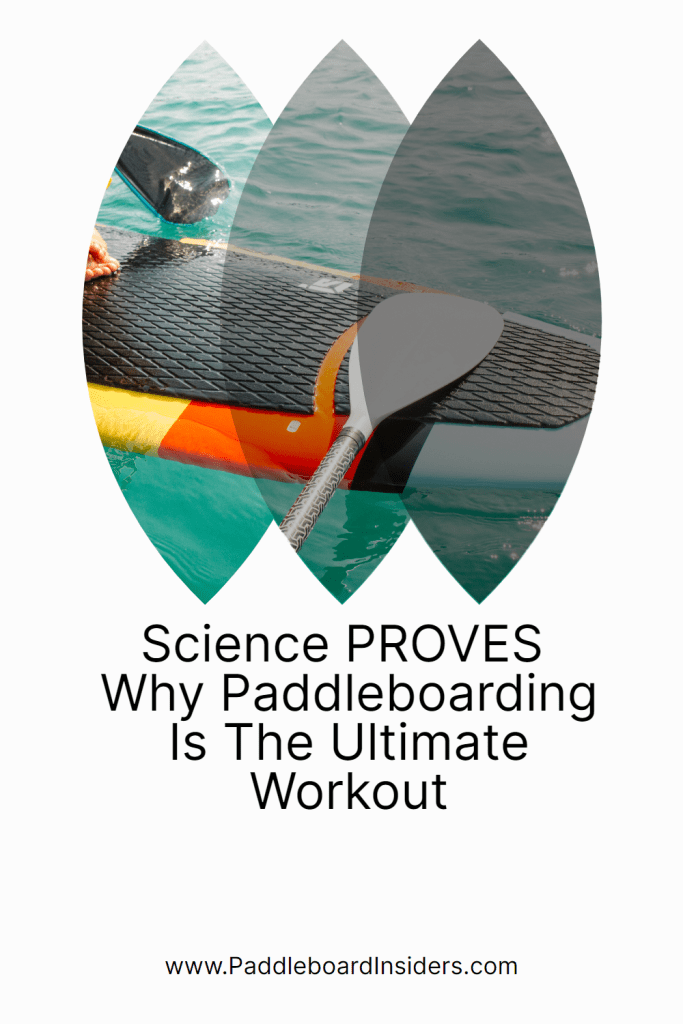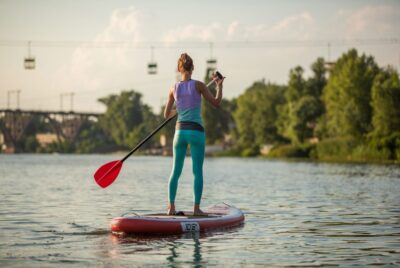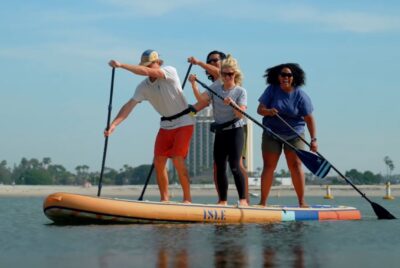New Science Reveals Why Paddleboarding Is The Ultimate Workout
*We may earn a commission for purchases made using our links. Please see our disclosure to learn more.
Is paddleboarding a good workout? This is a question that I’ve heard so many times over the last few years.
So today – I am excited to share the scientific reasons behind why paddleboarding is not just an enjoyable activity but also an incredible workout. In this article, we will explore the science behind paddleboarding, its numerous physical and mental health benefits, and provide valuable tips to make your paddleboarding workouts effective and safe.
Let’s go.
| Looking for our best paddle board product recommendations? Check the Paddleboard Insiders Buyer Guides |
Table Of Contents
Is Paddleboarding A Good Workout?
Paddleboarding has gained popularity worldwide as a recreational water sport, but what many people may not realize is the science-backed evidence that supports its effectiveness as a workout. Whether you’re a beginner or an experienced paddler, understanding the science behind paddleboarding can enhance your appreciation for the sport and motivate you to incorporate it into your fitness routine.
| Here are some of my favorite beginner paddle boards of 2025 7 Incredible Beginner Paddleboards To Buy In 2025 On A Budget |
The Science Behind Paddleboarding:
Full-Body Engagement
Paddleboarding is a full-body workout that engages multiple muscle groups simultaneously. When you paddle, you use the muscles in your arms, shoulders, and back to propel the board forward through the water. These movements provide resistance, stimulating muscle fibers and promoting strength development in your upper body.

At the same time, maintaining balance on the paddleboard requires constant adjustments, which engage your core muscles. Your abdominal muscles, obliques, and lower back muscles work together to stabilize your body, ensuring you stay upright on the board. The continual engagement of these core muscles during paddleboarding helps strengthen and tone your midsection.
Core Activation
Balance plays a crucial role in paddleboarding, and this is where your core muscles shine. While standing on the board and maneuvering through the water, your core muscles are constantly working to maintain stability and support your body weight. This sustained activation of the core muscles helps strengthen them over time, improving your overall balance and stability.

Moreover, the dynamic nature of paddleboarding requires your core muscles to stabilize your body as you paddle through water currents, wind, and waves. This adds an extra challenge and increases the intensity of your workout, providing additional stimulus for core muscle development.
Balance and Stability
Paddleboarding demands a high level of balance and stability. Your body adjusts to the shifting weight distribution on the board as you paddle and navigate the water. This constant balancing act activates the proprioceptive system, which includes sensory receptors in your muscles and joints responsible for spatial awareness and balance.
As you refine your paddleboarding skills, your proprioceptive system becomes more adept at maintaining balance. This improvement transfers to other physical activities and everyday movements, enhancing your overall sense of balance and reducing the risk of falls or injuries.
Some Exciting Health Benefits of Paddleboarding:
Aside from the science behind paddleboarding, there are numerous physical and mental health benefits associated with this water-based workout.
Cardiovascular Health
Engaging in paddleboarding regularly contributes to cardiovascular fitness. As you paddle, your heart rate increases, delivering oxygen and nutrients to your muscles and organs. This aerobic exercise strengthens your heart, improves circulation, and enhances your overall cardiovascular health.
Paddleboarding provides a low-impact alternative to traditional cardiovascular exercises like running or high-intensity interval training. The buoyancy of the water reduces stress on your joints, making it suitable for individuals with joint issues or those who prefer low-impact activities.
Low Impact on Joints
One of the key advantages of paddleboarding is its low impact on joints. Unlike activities that involve repetitive pounding on hard surfaces, paddleboarding is gentle on your knees, hips, and ankles. The water’s buoyancy cushions your movements, reducing the risk of joint strain or injury. This makes paddleboarding accessible to a wide range of individuals, including those with joint conditions or older adults seeking a joint-friendly workout.
Promotes Strong Mental Well-being
Paddleboarding not only benefits your physical health but also has a positive impact on your mental well-being. Spending time on the water can be incredibly calming and therapeutic, allowing you to escape the stresses of daily life and immerse yourself in the present moment.
The rhythmic motion of paddling, the sound of water, and the serenity of nature create a soothing environment that promotes relaxation and stress reduction. Paddleboarding provides an opportunity to connect with nature, rejuvenate your mind, and find a sense of tranquility.

Tips for an Amazing Paddleboarding Workout:
To make the most out of your paddleboarding workouts and ensure a safe and enjoyable experience, consider the following tips:
Tip 1 – Technique and Form
Learning and practicing proper paddleboarding technique is essential to optimize your workout. This includes using the correct grip on the paddle, engaging your core muscles, and maintaining a smooth and efficient paddling motion. Taking lessons or seeking guidance from experienced paddleboarders can help you refine your technique and improve your efficiency on the water.
Tip 2 – Setting Goals and Progression
Like any other workout, setting goals and tracking your progress can keep you motivated and engaged. Start with achievable goals, such as paddling for a certain distance or completing a specific route. Gradually increase the intensity, duration, or distance of your paddleboarding sessions as your fitness level improves. Celebrate your milestones along the way to stay inspired and continue challenging yourself.
Tip 3 – Safety Considerations
Prioritize your safety while paddleboarding. Always wear a properly fitted personal flotation device (PFD) to ensure buoyancy and protection. Additionally, use a leash to secure yourself to the board, preventing it from drifting away in case of a fall. Check weather conditions before heading out and avoid paddleboarding in strong winds or rough waters. Familiarize yourself with local regulations and paddle in designated areas. Lastly, be aware of potential hazards in the water, such as rocks or strong currents.
Conclusion: Is Paddleboarding Good Exercise?
Paddleboarding is more than just a recreational activity; it is a scientifically proven, full-body workout with numerous physical and mental health benefits. The combination of engaging multiple muscle groups, activating your core, improving balance and stability, and promoting cardiovascular health makes paddleboarding an exceptional exercise option for individuals of all fitness levels.
So grab your paddleboard, explore serene waters, and experience the joy and rewards of paddleboarding. Embrace the scientific evidence supporting its effectiveness as a workout and enjoy the overall well-being it brings.
| Looking for insider guides to some amazing paddle boarding locations? Check the Paddleboard Insiders Location Guides |
FAQs (Frequently Asked Questions)
Is paddleboarding suitable for beginners?
Absolutely! Paddleboarding can be enjoyed by beginners with no prior experience. It’s essential to start in calm waters and take the time to learn proper technique and balance. With practice and patience, anyone can become proficient in paddleboarding.
Do I need to be a good swimmer to paddleboard?
While basic swimming skills are beneficial, paddleboarding itself doesn’t require advanced swimming abilities. Wearing a PFD and using a leash can provide additional safety and reassurance, especially for those who may not be confident swimmers.
Use this guide for the most essential paddleboarding accessories that you need when paddling.
What if I fall off the paddleboard? Is it difficult to get back on?
Falling off the paddleboard is part of the learning process, and it happens to everyone. Getting back on the board is relatively easy, and you can use a technique called “deep-water re-entry” or climb back on from the side. With practice, you’ll become more comfortable with re-entering the board.
Can I paddleboard in any body of water?
Paddleboarding can be enjoyed in various bodies of water, including lakes, rivers, and oceans. It’s important to consider the water conditions, such as wind, currents, and tides, to ensure your safety and make an informed decision about where to paddleboard.
Can paddleboarding help with weight loss?
Paddleboarding can contribute to weight loss and improved body composition when combined with a healthy diet and regular exercise. It provides a calorie-burning workout that engages multiple muscle groups, helping you burn fat and build lean muscle.
Remember, paddleboarding not only offers a fantastic workout but also allows you to connect with nature, find peace on the water, and improve your overall well-being. So get out there, paddle, and embrace the transformative power of this amazing water sport!





